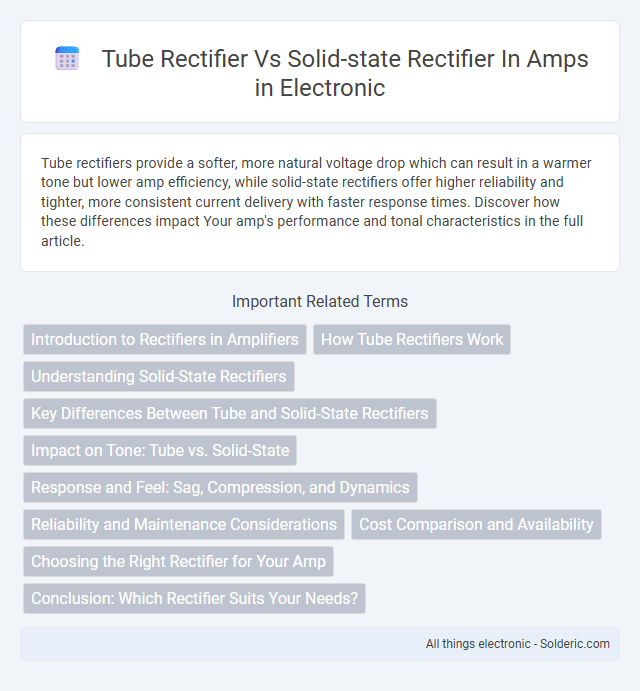Tube rectifiers provide a softer, more natural voltage drop which can result in a warmer tone but lower amp efficiency, while solid-state rectifiers offer higher reliability and tighter, more consistent current delivery with faster response times. Discover how these differences impact Your amp's performance and tonal characteristics in the full article.
Comparison Table
| Feature | Tube Rectifier | Solid-State Rectifier |
|---|---|---|
| Current Capacity (Amps) | Typically 10-50 Amps | Typically 10-1000+ Amps |
| Surge Current Handling | Lower surge current capability | High surge current capability |
| Voltage Drop | Higher voltage drop (~20-30V) | Lower voltage drop (~1-2V) |
| Reliability | Lower, tubes degrade over time | High, solid-state components last longer |
| Size & Weight | Larger and heavier | Compact and lightweight |
Introduction to Rectifiers in Amplifiers
Tube rectifiers in amplifiers provide a warm, vintage tonal characteristic due to their inherent voltage drop and slower response time, which can subtly compress the audio signal. Solid-state rectifiers offer a more stable and efficient power supply with faster response and minimal voltage loss, resulting in tighter bass and increased headroom. The choice between tube and solid-state rectifiers significantly influences the amplifier's tonal dynamics, affecting overall sound quality and performance.
How Tube Rectifiers Work
Tube rectifiers convert alternating current (AC) to direct current (DC) by heating a cathode inside a vacuum tube, which emits electrons that flow to the anode, allowing current to pass in one direction only. This process creates a natural voltage sag under load, resulting in a softer, more musical response preferred by many guitarists for amp tone. Your choice between tube and solid-state rectifiers impacts tonal characteristics, with tube rectifiers offering warmth and dynamic feel that solid-state types typically lack.
Understanding Solid-State Rectifiers
Solid-state rectifiers in amps offer higher efficiency and longer lifespan compared to tube rectifiers, as they use semiconductor diodes to convert AC to DC without the heat generation typical of tubes. These rectifiers provide faster response times and lower internal resistance, resulting in improved voltage regulation and consistent power delivery. The compact size and reliability make solid-state rectifiers the preferred choice in modern amplifier designs, enhancing durability and performance.
Key Differences Between Tube and Solid-State Rectifiers
Tube rectifiers offer smoother voltage delivery and natural compression, enhancing your amplifier's tonal warmth and dynamic response. Solid-state rectifiers provide faster response times, higher reliability, and increased efficiency with less maintenance required. These key differences significantly impact the amp's sound character, with tube rectifiers favored for vintage tone and solid-state models preferred for consistency and durability.
Impact on Tone: Tube vs. Solid-State
Tube rectifiers in amps contribute to a warmer, more dynamic tone with natural compression and slight voltage sag, enhancing musical expressiveness and vintage character. Solid-state rectifiers provide a tighter, more consistent response with faster attack and higher headroom, resulting in a cleaner, more precise sound. Your choice between tube and solid-state rectifiers significantly affects the amp's tonal feel and responsiveness, shaping the overall playing experience.
Response and Feel: Sag, Compression, and Dynamics
Tube rectifiers in amps produce a natural voltage sag that creates a warm compression and smooth dynamic response, favored for its organic feel and musicality. Solid-state rectifiers deliver a consistent and tight voltage supply, resulting in faster response with less sag, sharper attack, and cleaner dynamics. The choice between tube and solid-state rectifiers significantly affects tonal character and playing feel, with tubes offering vintage warmth and solids providing precision and clarity.
Reliability and Maintenance Considerations
Tube rectifiers in amps often require more frequent maintenance due to their vacuum tube components, which can wear out and cause reliability issues over time. Solid-state rectifiers use semiconductor diodes that provide greater longevity and consistent performance with minimal upkeep. You will find that solid-state rectifiers typically enhance overall amp reliability and reduce the need for routine servicing.
Cost Comparison and Availability
Tube rectifiers tend to be more expensive and harder to find due to their vintage design and limited production compared to solid-state rectifiers, which are widely available and cost-effective. Solid-state rectifiers offer greater availability in the market, making replacements more accessible and affordable for your amp needs. The higher cost of tube rectifiers often reflects their specialized sound quality and unique characteristics rather than mass-market efficiency.
Choosing the Right Rectifier for Your Amp
Tube rectifiers in amps provide a warm, vintage tone with natural compression and voltage sag, ideal for blues and classic rock players seeking dynamic response. Solid-state rectifiers deliver consistent, tight power with low noise and higher reliability, favored by metal and modern players requiring precise attack and clarity. Choosing the right rectifier depends on your desired tonal characteristics and playing style, ensuring your amp complements your sound and performance needs.
Conclusion: Which Rectifier Suits Your Needs?
Tube rectifiers offer a warm, vintage tonal character favored in blues and classic rock amps, providing natural compression and smoother voltage sag, while solid-state rectifiers deliver more consistent power with faster response and higher reliability, ideal for modern high-gain tones and heavier styles. Your choice depends on whether you prioritize classic warmth and dynamic feel or tight, punchy output and durability. Evaluating your playing style and tonal preferences will help determine the rectifier that best suits your amp and musical needs.
Tube rectifier vs Solid-state rectifier in amps Infographic

 solderic.com
solderic.com